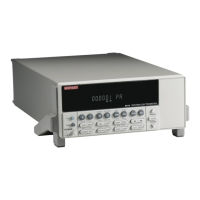6-2 Range, Units, Digits, Rate, and Filters
Range, units, and digits
Range
The ranges for each measurement function are listed in Table 6-1. The range setting (fixed or
AUTO) is remembered by each function.
The full scale readings for every measurement range are 5% over range. For example, on the
20V range, the maximum input voltage is ± 21V. Input values that exceed the maximum readings
cause the overflow message (“OVERFL0W”) to be displayed.
Manual ranging
To select a range, press the RANGE or key. The instrument changes one range per
key-press. The selected range is displayed momentarily. If the instrument displays the “OVER-
FLOW” message on a particular range, select a higher range until an on-range reading is dis-
played. Use the lowest range possible without causing an overflow to ensure best accuracy and
resolution.
Autoranging
When using autorange, the instrument automatically goes to the most sensitive available
range to measure the applied signal. Up-ranging occurs at 105% of range, while down-ranging
occurs at the range value. For example, if on the 20V range, the instrument will go up to the
200V range when the input signal exceeds 21V. While on the 200V range, the instrument will
go down to the 20V range when the input level goes to 20V.
The AUTO key toggles the instrument between manual ranging and autoranging. The AUTO
annunciator turns on when autoranging is selected. To disable autoranging, press AUTO or the
RANGE
or key. Pressing AUTO to disable autoranging leaves the instrument on the present
range.
Table 6-1
Measurement ranges
V I Ω Q
2V 20pA 2kΩ 20nC
20V 200pA 20kΩ 200nC
200V 2nA 200kΩ 2µC
20nA 2MΩ 20µC
200nA 20MΩ
2uA 200MΩ
20uA 2GΩ
200uA 20GΩ
2mA 200GΩ
20mA

